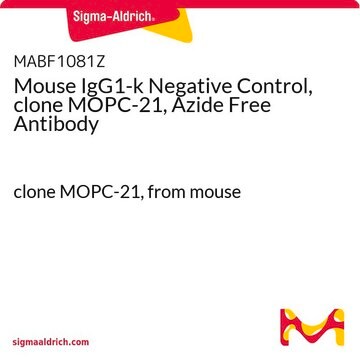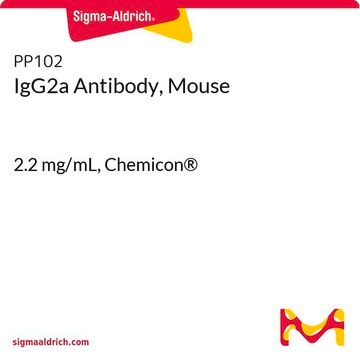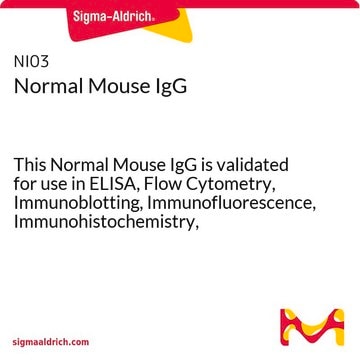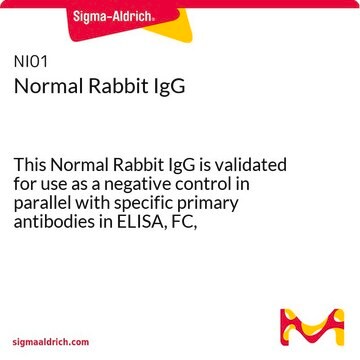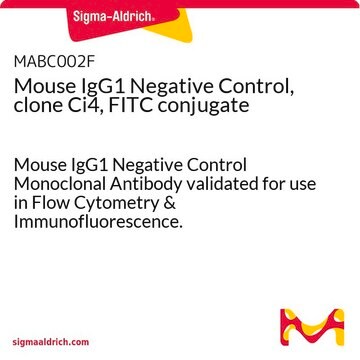MABC002
Mouse IgG1 Negative Control, clone Ci4
Mouse IgG1 Negative Control Monoclonal Antibody validated for use in Flow Cytometry & Immunofluorescence.
Sign Into View Organizational & Contract Pricing
All Photos(1)
About This Item
UNSPSC Code:
12352203
eCl@ss:
32160702
NACRES:
NA.42
Recommended Products
biological source
mouse
Quality Level
antibody form
purified immunoglobulin
clone
Ci4, monoclonal
manufacturer/tradename
Chemicon®
concentration
0.5 mg/mL
technique(s)
flow cytometry: suitable
immunofluorescence: suitable
isotype
IgG1
shipped in
wet ice
target post-translational modification
unmodified
General description
Immunoglobulin G (IgG), is one of the most abundant proteins in human serum with normal levels between 8-17 mg/mL in adult blood. IgG is important for our defence against microorganisms and the molecules are produced by B lymphocytes as a part of our adaptive immune response. The IgG molecule has two separate functions; to bind to the pathogen that elicited the response and to recruit other cells and molecules to destroy the antigen. The variability of the IgG pool is generated by somatic recombination and the number of specificities in an individual at a given time point is estimated to be 1011 variants.
Specificity
Reacts with chicken immunoglobulin. No reaction with human cell surface or plasma components has been observed. However some binding to Fc receptors may occur.
Immunogen
Chicken immunoglobulin
Application
Mouse IgG1 Negative Control Monoclonal Antibody validated for use in Flow Cytometry & Immunofluorescence.
Mouse IgG1 is a monoclonal antibody intended for use as a negative control in immunofluorescence, flow cytometry, and immunoperoxidase staining on frozen and paraffin tissue sections. Its use enables an estimation of non-specific binding of mouse monoclonal antibodies to cell surface components in peripheral blood and tissue.
SUGGESTED USAGE
The control antibody should be diluted to the same concentration as the test antibody, and equivalent volumes used.
SUGGESTED USAGE
The control antibody should be diluted to the same concentration as the test antibody, and equivalent volumes used.
Research Category
Secondary & Control Antibodies
Epitope Tags & General Use
Secondary & Control Antibodies
Epitope Tags & General Use
Research Sub Category
Isotype Control Antibodies
Isotype Control Antibodies
Physical form
Format: Purified
Protein A Purified mouse immunoglobulin in phosphate buffered saline, pH 7.4, containing 0.2% bovine Serum albumin and 0.1% sodium azide.
Protein A purified
Storage and Stability
Maintain for 1 year at 2–8°C from date of shipment. For maximum recovery of product, centrifuge the original vial after thawing and prior to removing the cap.
Legal Information
CHEMICON is a registered trademark of Merck KGaA, Darmstadt, Germany
Disclaimer
Unless otherwise stated in our catalog or other company documentation accompanying the product(s), our products are intended for research use only and are not to be used for any other purpose, which includes but is not limited to, unauthorized commercial uses, in vitro diagnostic uses, ex vivo or in vivo therapeutic uses or any type of consumption or application to humans or animals.
Storage Class Code
12 - Non Combustible Liquids
WGK
WGK 2
Flash Point(F)
Not applicable
Flash Point(C)
Not applicable
Certificates of Analysis (COA)
Search for Certificates of Analysis (COA) by entering the products Lot/Batch Number. Lot and Batch Numbers can be found on a product’s label following the words ‘Lot’ or ‘Batch’.
Already Own This Product?
Find documentation for the products that you have recently purchased in the Document Library.
Liku B Tezera et al.
eLife, 9 (2020-02-25)
Previously, we developed a 3-dimensional cell culture model of human tuberculosis (TB) and demonstrated its potential to interrogate the host-pathogen interaction (Tezera et al., 2017a). Here, we use the model to investigate mechanisms whereby immune checkpoint therapy for cancer paradoxically
Sandra Rizzi et al.
Biochemistry and biophysics reports, 4, 291-298 (2015-10-09)
The sodium-activated potassium channels Slick (Slo2.1, KCNT2) and Slack (Slo2.2, KCNT1) are paralogous channels of the Slo family of high-conductance potassium channels. Slick and Slack channels are widely distributed in the mammalian CNS and they play a role in slow
Lukas Amrell et al.
Cancer cell international, 24(1), 277-277 (2024-08-07)
Tucatinib (TUC), a HER2-directed tyrosine kinase inhibitor, is the first targeted drug demonstrating intracranial efficacy and significantly prolonged survival in metastatic HER2-positive breast cancer (BC) patients with brain metastases. Current treatments for brain metastases often include radiotherapy, but little is
E-cadherin and its downstream catenins are proteolytically cleaved in human HaCaT keratinocytes exposed to UVB.
Hung, Chi-Feng, et al.
Experimental Dermatology, 15, 315-321 (2006)
Differential distribution of the sodium-activated potassium channels slick and slack in mouse brain.
Sandra Rizzi et al.
The Journal of comparative neurology, 524(10), 2093-2116 (2015-11-21)
The sodium-activated potassium channels Slick (Slo2.1, KCNT2) and Slack (Slo2.2, KCNT1) are high-conductance potassium channels of the Slo family. In neurons, Slick and Slack channels are involved in the generation of slow afterhyperpolarization, in the regulation of firing patterns, and
Our team of scientists has experience in all areas of research including Life Science, Material Science, Chemical Synthesis, Chromatography, Analytical and many others.
Contact Technical Service



